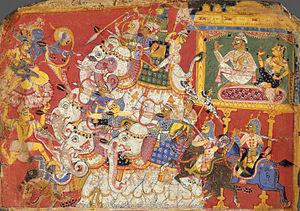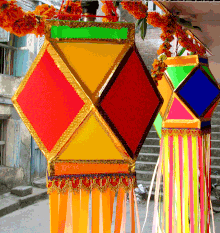Spiritual significance
In each legend, tradition and story of Deepawali lies the significance of the victory of good over evil; and it is with each Deepawali and the lights that illuminate our homes and hearts, that this simple truth finds new reason and hope. From darkness into light — the light that empowers us to commit ourselves to good deeds, that which brings us closer to divinity. During Diwali, lights illuminate every corner of India and the scent of incense sticks hangs in the air, mingled with the sounds of fire-crackers, joy, togetherness and hope. Diwali is celebrated around the globe. Outside India, it is more than a Hindu festival, it is a celebration of South-Asian identities.
While Deepavali is popularly known as the "festival of lights", the most significant spiritual meaning is "the awareness of the inner light". Central to Hindu philosophy is the assertion that there is something beyond the physical body and mind which is pure, infinite, and eternal, called the Atman. The celebration of Deepavali as the "victory of good over evil", refers to the light of higher knowledge dispelling all ignorance, the ignorance that masks one's true nature, not as the body, but as the unchanging, infinite, immanent and transcendent reality. With this awakening comes compassion and the awareness of the oneness of all things (higher knowledge). This brings anand (joy or peace). Just as we celebrate the birth of our physical being, Deepavali is the celebration of this Inner Light.
While the story behind Deepavali and the manner of celebration varies from region to region (festive fireworks, worship, lights, sharing of sweets), the essence is the same – to rejoice in the Inner Light (Atman) or the underlying Reality of all things (Brahman).
Dates
Diwali falls on the one new moon night between mid-October and mid-November. Deepavali is celebrated for five days according to the lunisolarHindu Calendar. It begins in late Ashvin (between September and October) and ends in early Kartika (between October and November). The first day is Dhan Teras. The last day is Yama Dvitiya, which signifies the second day of the light half of Kartika. Each day of Deepavali marks one celebration of the six principal stories associated with the festival.
Hindus have several significant events associated with Diwali:
- The return of Rama after 14 years of Vanvas (banishment). To welcome his return, diyas (ghee lamps) were lit in rows of 20.
- The killing of Narakasura: Celebrated as Naraka Chaturdashi, one day before Deepavali, it commemorates the killing of the evil demon Narakasura, who wreaked havoc. Krishna's wife Satyabhama killed Narakasura during the Dwapara yuga. In another version of the belief, the demon was killed by Krishna or Krishna provoked his wife Satyabhama to kill Narshna, defeating Indra.
- Govardhan Puja is celebrated the day after Deepavali and is the day Krishna defeated Indra, the deity of thunder and rain. According to the story, Krishna saw preparations for an annual offering to Lord Indra and asked his father Nanda about it. He debated with the villagers about what their 'dharma' truly was. They were farmers, they should do their duty and concentrate on farming and protection of their cattle. He said that all human beings should do their 'karma' to the best of their ability and not pray for natural phenomenon. The villagers were convinced by Krishna, and did not proceed with the special puja (prayer). Indra was then angered, and flooded the village. Krishna lifted Mount Govardhanand held it up to protect the people and cattle from the rain. Indra finally accepted defeat and recognized Krishna as supreme. Although this aspect of Krishna's life is sometimes ignored it sets up the basis of the 'karma' philosophy later detailed in the Bhagavat Gita.
Other events associated with Diwali include:
- Return of Pandavas after 12 years of Vanvas and one year of agyatavas (living incognito).
Deepavali celebrations are spread over five days, from Dhanteras to Bhaiduj. In some places like Maharshtra it starts with Vasu Baras.All the days except Diwali are named according to their designation in the Hindu calendar. The days are:
- Govatsa Dwadashi or Vasu Baras (27 Ashvin or 12 Krishna Paksha Ashvin): Go means cow and vatsa means calf. Dwadashi or Barasmeans the 12th day. On this day the cow and calf are worshiped. The story associated with this day is that of King Prithu, son of the tyrant King Vena. Due to the ill rule of Vena, there was a terrible famine and earth stopped being fruitful. Prithu chased the earth, who is usually represented as cow, and ‘milked’ her, meaning that he brought prosperity to the land.
- Dhanatrayodashi or Dhan teras or Dhanwantari Triodas (28 Ashvin or 13 Krishna Paksha Ashvin): Dhana means wealth andTrayodashi means 13th day. This day falls on the 13th day of the second half of the lunar month. It is considered an auspicious day for buying utensils and gold, hence the name ‘Dhana’. This day is regarded as the Jayanti (Birth Anniversary) of God Dhanvantari, the Physician of Gods, who came out during Samudra manthan, the churning of the great ocean by the gods and the demons.
- Naraka Chaturdashi (29 Ashvin or 14 Krishna Paksha Ashvin): Chaturdashi is the 14th day This was the day on which the demon Narakasura was killed by Krishna – an incarnation of Vishnu. It signifies the victory of good over evil and light over darkness (Gujarati: Kali Chaudas, Rajasthan : Roop Chaudas). In southern India, this is the actual day of festivities. Hindus wake up before dawn, have a fragrant oil bath and dress in new clothes. They light small lamps all around the house and draw elaborate kolams /rangolis outside their homes. They perform a special puja with offerings to Krishna or Vishnu, as he liberated the world from the demon Narakasura on this day. It is believed that taking a bath before sunrise, when the stars are still visible in the sky is equivalent to taking a bath in the holyGanges. After the puja, children burst firecrackers heralding the defeat of the demon. As this is a day of rejoicing, many will have very elaborate breakfasts and lunches and meet family and friends.
- Lakshmi Puja (30 Ashvin or 15 Krishna Paksha Ashvin): Lakshmi Puja marks the most important day of Diwali celebrations in North India. Hindu homes worship Lakshmi, the goddess of wealth, and Ganesh, the God of auspicious beginnings, and then light lamps in the streets and homes to welcome prosperity and well-being.
- Bali Pratipada and Govardhan Puja (1 Kartika or 1 Shukla Paksha Kartika) : In North India, this day is celebrated as Govardhan Puja, also calledAnnakoot, and is celebrated as the day Krishna – an incarnation of god Vishnu – defeated Indra and by the lifting of Govardhana hill to save his kinsmen and cattle from rain and floods. For Annakoot, large quantities of food are decorated symbolizing the Govardhan hill lifted by Krishna. InMaharashtra, Tamil Nadu and Karnataka, it is celebrated as Bali-Pratipada or Bali Padyami. The day commemorates the victory of Vishnu in his dwarf form Vamana over the demon-king Bali, who was pushed into the patala. In Maharashtra, it is called as Padava or Nava Diwas (new day). Men present gifts to their wives on this day. It is celebrated as the first day of the Vikram Samvat calender, in Gujarat.
- Yama Dwitiya or Bhaiduj (also Bhayyaduj, Bhaubeej or Bhayitika) (2 Kartika or 2 Shukla Paksha Kartika): on this day, brothers and sisters meet to express love and affection for each other (Gujarati: Bhai Bij, Bengali: Bhai Phota). It is based on a story when Yama, lord of Death, visited his sisterYami (the river Yamuna). Yami welcomed Yama with an Aarti and they had a feast together. Yama gave a gift to Yami while leaving as a token of his appreciation. So, the day is also called 'YAMA DWITIYA'. Brothers visit their sisters’ place on this day and usually have a meal there, and also give gifts to their sisters.






Hi Dear, are you genuinely visiting this web site on a regular basis, if so then you will definitely get pleasant
ReplyDeleteknow-how.
My web blog ... facebook hack tool ()
I have been exploring for a little for any high quality articles oor blog posts in this kind
ReplyDeleteof space . Exploring in Yahoo I finally stumbled upon this webb
site. Reading this information So i'm satisfied to convey that I've an incredibly excellent uncanny feeling I came upon exactly what I needed.
I most surely will make certain to do not foget this website and provides it a glance oon a continuing basis.
Here is my webpage; Temple Run 2 Guides
Asking questions are genuinely pleasant thing if you are not understanding anything
ReplyDeletecompletely, however this piece of writing offers nice understanding even.
Here is my website erc vietnam
Very good blog! Do you have any hints for aspiring writers?
ReplyDeleteI'm planning tto start my own blog soon but I'm a little lost
on everything. Would you recommend starting with a free platform like Wordpress or go foor
a paid option? There are so many options oout there that I'm completely confused
.. Any suggestions? Appreciate it!
my site: racing rivals iphone tips ()
I visited various web sites except the audio feature for audio
ReplyDeletesongs current at this website is truly marvelous.
Feel free to visit my site: info bursa taruhan bola hari ini
Nice pоst. I leaгn somethіng totally new and challenging on sitеs I stumbleupon everyday.
ReplyDeleteIt's always interestіng to read through content from other authors and practіce a little something fгom their wweb sites.
my site: resell plr
Hey are using Wordpress for your site platform? I'm new to the blog
ReplyDeleteworld but I'm trying to get started and create my
own. Do you require any coding expertise to make your own blog?
Any help would be greatly appreciated!
Also visit my webpage :: casino
This is my first time visit at here and i am in fact happy to read
ReplyDeleteeverthing at one place.
Look at my website; click the following article
The Download group is committed to providing you with correct computer software data.
ReplyDeleteWindows 98 / Window Me / Windows 2000 / Windows
XP / Windows 2003 / Windows Vista / Windows 7 / Windows 8 / 8.1 operating program or above.
Heere iss my web page; poweriso crack